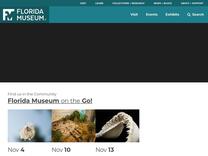An Absurd Book Review – For Educators https://www.floridamuseum.ufl.edu/educators/blogs/an-absurd-book-review/
I have always loved to read, but it is a pastime that I seldom find time for these days. As my schedule this summer began filling up—classes, interning, tutoring, general life stuff, etc. I realized, much to my dismay, this summer was not going to serve as an opportunity to catch up on the titles
think I enjoyed this book as much as I did because IÂ like the idea of an adult man

